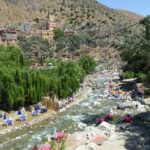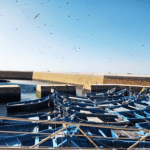Encompassing a vast stretch of northern Africa, the Sahara desert weather is as enigmatic and expansive as the desert itself. Known for its clear, star-studded skies and vast dunes, what is the weather like in the Sahara desert? During the day, temperatures soar, creating an arid landscape where only the hardiest of life forms can thrive. As the sunsets, the Sahara desert at night temperature plunges, offering a respite from the searing heat but also signaling the onset of a surprisingly cold environment.
The current temperature in the Sahara desert now shifts with the rising and setting of the sun, underscoring the desert’s dramatic temperature fluctuations. Those interested in the Sahara desert’s current temperature should be prepared for a climate that does not gently transition but abruptly changes, affecting everything from its ecology to the experience of travelers and adventurers within its bounds. Whether you’re seeking the Sahara desert weather today or an overall understanding of Sahara desert weather right now, insights into these patterns provide essential knowledge for anyone looking to journey beneath its open skies.
As twilight encroaches, the distinction between dusk and full darkness becomes a vivid display of nature’s cadence. Civil twilight provides that lingering glow, enabling one last glimpse at the horizon before night takes hold, while astronomical twilight ushers in the prime time for stargazers and the nocturnal denizens of the desert.
- Clear distinction between daytime heat and the cool of the Sahara night.
- Knowledge of the temperature in the Sahara Desert now is crucial for safety and comfort.
- Twilight periods provide a unique experience in the desert, with varying levels of visibility and light.
- Understanding Sahara desert weather is essential for planning outdoor activities.
- Preparation for sudden temperature shifts is key to navigating the desert environment.
- Regular weather updates can guide daily planning for Sahara explorers.
Understanding Sahara Desert Weather Patterns
Unraveling the complexities of Desert weather begins with comprehending the stark contrasts and unique meteorological conditions present in the Sahara. The region’s weather is shaped by two predominant climatic regimes, each influenced by their geographic proximity and coastal interactions, offering a challenging yet intriguing environment marked by extremes.
Impact of High-Pressure Cells over the Tropic of Cancer
The vast expanse of the Sahara Desert is profoundly affected by the stable high-pressure cells that reside over the Tropic of Cancer. These pressure systems govern the arid and volatile desert climate, resulting in wide temperature variations that underpin the sensory experience of heat during the day and a significant drop in Sahara desert humidity at night. Overarching this is the influence these systems have on regional morocco temperature April and October weather in Morocco, resulting in a weather pattern that is as riveting as it is demanding.
The contrast between the Dry Subtropical and Dry Tropical Climate
The northern swathes of the Sahara are characterized by a dry subtropical climate, illustrating an environment where diurnal temperature ranges can be extreme. These areas tend to experience cold winters that transition into hot, dry summers, punctuated by sporadic precipitation, which in turn can trigger flash floods. This creates unique seasonal shifts in the Morocco climate September that travelers should be acutely aware of before embarking on their desert adventures.
Moving southward, the dry tropical climate predominates. Here, the winters are milder, and the highs before the summer rains can be particularly brutal, a climate profile familiar to those monitoring Morocco’s temperature in October. As a consequence of these opposing forces, the climate in Morocco in October presents a different profile altogether compared to the rest of the year.
| Season | Morocco Temperature April | Morocco Temperature October | Humidity in the Sahara Desert (%) |
|---|---|---|---|
| Spring | Typically Warm | Mild to Warm | Low |
| Summer | — | Hot | Very Low |
| Autumn | — | Mild to Warm | Low to Moderate |
| Winter | Cool to Mild | — | Highest |
The impact of the Coastal areas and the prevailing Canary Current also deserve mention, as they bring cooler conditions that soften the otherwise harsh desert climate. The thread connecting all these components is the proactive and informed approach that one must adopt to navigate through the shifting Desert weather, guaranteeing a journey as safe as it is unforgettable in the great Sahara.
Seasonal Variations of Climate in the Sahara
The Sahara desert, with its sweeping dunes and vast horizons, experiences profound seasonal variations in climate that have fascinated scientists and travelers alike. Understanding these changes is critical for anyone planning to visit or study this unique biome. Spring and autumn offer a welcoming balance, with hot days followed by cool nights. However, as the summer months set in, the temperature can soar to over 100°F (40°C), creating an intense, dry heat that cascades over the desert sands, only to be tempered by the arrival of cooler evenings.
Come winter, the Sahara transforms once more, introducing the coldest and most humid conditions of the year. This season is marked by crisp nights, where temperatures can plummet, juxtaposed against the mild warmth of the daytime sun. This oscillation between extremes is not only a hallmark of the Sahara desert weather but also an important consideration for the timing of travel and research in the region.
November weather in Morocco begins to reflect the onset of cooler temperatures, a precursor to the cold nights to come. The temp Morocco in November is pleasantly mild, making it a popular period for visitors who wish to avoid the oppressive heat of summer months. Conversely, morocco weather in May signifies the gentle upward trend toward warmer days indicative of the impending summer season.
The Sahara’s stark weather contrasts are especially pronounced when considering Morocco Marrakech’s weather in June and Morocco’s temperature in July. These mid-year months are characterized by some of the highest temperatures, signaling the peak of Saharan summer. Yet even in these sweltering months, the nights bring a surprising reprieve from the day’s scorching heat.
The weather patterns of the Sahara Desert extend beyond pure meteorological interest; they shape the livelihoods and traditions of the indigenous peoples, influence the types of flora and fauna that can thrive, and present unique challenges and opportunities for sustainable development and tourism.
| Month | Daytime High | Nighttime Low | General Weather Condition |
|---|---|---|---|
| May (Morocco) | Hot | Cool | Transitioning to summer |
| June (Marrakech) | Very Hot | Mildly Cool | Peak of summer heat |
| July (Morocco) | Extremely Hot | Mildly Cool | Intense summer heat |
| November (Morocco) | Mild | Chill begins setting in | Autumnal cooldown |
For the discerning traveler or researcher, these patterns are more than just a curiosity; they are a vital component in planning for a successful venture into the Sahara Desert. The region’s weather is emblematic of the desert’s allure and harsh beauty – a reminder of nature’s extremes and the adaptability required to thrive within them.
Temperature Extremes: From Scorching Heat to Chilly Nights
The Sahara Desert is a land of intense temperature extremes, where the mercury dances wildly across the thermometer in both daily and seasonal cycles. The searing August Marrakech weather stands testament to the desert’s oppressive summer heat, which can rival the hottest temperatures recorded globally. Yet as winter approaches, the Marrakech temperature in December drops significantly, revealing the desert’s ability to swing from one extreme to the other with little warning.
These fluctuations become even more pronounced as one explores various points throughout the year. Travelers braving the Sahara in winter may find the Marrakech weather in February surprisingly mild during the day, with the sun bestowing enough warmth to soften the chilly air. However, February temperatures in Morocco can swiftly dip after sunset, transforming the desert into a frigid scape where nighttime temperatures warrant heavy layers.
Daily and Annual Temperature Ranges in the Desert
The Sahara does not do subtlety when it comes to temperatures; the daily ranges are remarkable. The Sahara Desert at night becomes reminiscent of a different world compared to its daytime counterpart, illustrating how temperatures can swing dramatically within the same 24-hour period. The temperature in Morocco in September begins to decline from the summer’s peak, introducing a period of more manageable warmth that precedes the winter chill. This time of reduced extremes offers an ideal period for explorers to venture into the desert’s heart.
Record Temperatures and What They Tell Us
Record temperatures in the Sahara speak volumes about the region’s capacity for climatic drama. The highest temperatures, often observed in the midday summer sun, propel the Sahara into the upper echelons of heat experienced on the planet. Similarly, the region’s ability to cool off demonstrates a coldness that can challenge the unprepared. Such temperature dynamics are more than just numbers; they illuminate the desert’s ecology, influence human habitation patterns, and dictate the terms of survival in this harshest of environments.
| Month | Typical Daytime High | Typical Nighttime Low |
|---|---|---|
| February (Marrakech) | Comfortably Warm | Chilly |
| August (Marrakech) | Scorching Hot | Moderately Cool |
| December (Marrakech) | Mild | Cold |
The Sahara’s meteorological quirks render it a landscape of contrasts and extremes, from the heights of its summer zenith to the depths of its winter nadir. Staying informed and prepared for these fluctuations, alongside observing the record temperatures, adds a layer of vital understanding to anyone experiencing or studying the region.
Sahara Desert Weather: An Exploration Through the Months
Throughout the year, the Sahara Desert exhibits a diverse range of weather patterns that are as dynamic and variable as the desert’s landscape. Known for its year-round clarity, each month in the Sahara brings a new facet of its environmental character to light. For those planning a journey, an understanding of the region’s monthly climate is as crucial as the essentials in their backpacks. From the cool breezes accompanying the weather in Morocco in February to the sweltering July weather Morocco offers, the desert’s temperament evolves with the calendar.
Travelers en route to the Sahara can expect milder conditions with chilly nights in the winter months. Data from Merzouga-Erg Chebbi, which serves as a reliable climate estimate for the desert at large, points to a significant drop in night-time temperatures, particularly in the Marrakech Morocco weather in December. Conversely, the summer months spell an onslaught of heat, with daily temperatures frequently scaling the heights of discomfort. The importance of preparation is never overstated, whether one wishes to experience the relatively cool Marrakech temperature in October or the vibrant warmth of the Morocco weather in April Fahrenheit readings.
- February in Morocco: Known for its temperate days and crisp nights, packing a range of clothing is key.
- April in Marrakech: Pleasingly warm weather perfect for exploration, with comfortable evening temperatures.
- October in Marrakech: Warm afternoons ease into gentle nights, requiring lighter attire.
- December in Morocco: A cooler affair with the potential for cold nights, suggest layers, and warm evening gear.
- July in Morocco: Bracing for the heat is essential, as the desert reveals its fiercest face with extreme temperatures.
| Month | Typical Weather in Sahara | Average Daytime Temperature | Average Nighttime Temperature |
|---|---|---|---|
| February | Clear and Cool | 68°F (20°C) | 43°F (6°C) |
| April | Pleasantly Warm | 77°F (25°C) | 54°F (12°C) |
| July | Intensely Hot | 104°F (40°C) | 86°F (30°C) |
| October | Mild Warmth | 82°F (28°C) | 60°F (16°C) |
| December | Cool with Mild Days | 63°F (17°C) | 37°F (3°C) |
While visitors are often drawn by the lure of the desert’s vast emptiness and serenity, the reality of its climate can be as testing as it is enamoring. The Marrakech Morocco weather in April offers a welcoming embrace for the traveler, but only a few months later, the same sands will bake under the intense Marrakech Morocco weather in December. It is in these transitions, from the Morocco December temperature to the rise of mercury in the July weather Morocco, that the true essence of the Sahara’s ever-changing climate is revealed.
Navigating the Sahara: Weather Conditions by Region
Voyaging through the Sahara Desert requires an intricate understanding of its diverse weather patterns. Varying profoundly by region, these climatic nuances significantly influence travel and exploration. North-to-south gradients and the effects of coastal currents represent the desert’s competing environmental forces that visitors must contend with when planning their desert expeditions.
The Difference in Climate from North to South
In the vast and sandy expanse of the Sahara, climate conditions exhibit striking variability moving from north to south. The northern regions are dominated by a dry subtropical climate whose trademark is significant annual and diurnal temperature shifts. Monitoring the temp in Marrakech in March reveals pleasantly warm afternoons, quickly transforming into cooler evenings. This contrast is even more palpable when one experiences the chill in the Morocco climate in December, which calls for layers of clothing soon after the sun dips below the dunes.
As one travels southward, the dry tropical climate emerges, a stark difference shaped by the interplay of continental air masses. The barometer records higher daily temperatures, with a reduced range between day and night, as reflected in the weather in Marrakech Morocco in May. This pattern is crucial for anyone assessing the broader weather Morocco October forecasts, which can vary by several degrees across the desert’s broad expanse.
Coastal Zone Weather Influenced by the Canary Current
The Sahara’s coastal zone stands as a climatic outlier within the desert’s weather system, where the cool Canary Current significantly shapes the environmental conditions. This marine influence moderates temperatures and yields higher humidity levels along the Western Sahara edge. Tourists intrigued by the October weather in Marrakech can expect milder warmth and the occasional foggy mornings near coastal regions, in stark contrast to the more extreme inland areas.
Coastal Sahara weather, particularly during weather in Morocco in April, showcases a gentle balancing act between desert warmth and oceanic coolness, a pattern not seen in the more central parts of the Sahara. So while the inland Marrakech weather in December may have travelers bundling up in the evenings, those along the coast might enjoy a more constant temperature range.
- Ocean influences lead to cooler temperatures and higher humidity in coastal areas
- The dry subtropical climate of the northern Sahara with wide temperature ranges and occasional precipitation
- The dry tropical climate of the southern Sahara with typically higher temperatures and milder nights
- Travelers can enjoy milder Morocco weather in October along the coast, thanks to the Canary Current’s impacts
Rare Precipitation and Dramatic Weather Phenomena
Amidst the undulating sands of the Sahara, the occurrence of rare precipitation can be as awe-inspiring as it is infrequent. The average yearly downpour scarcely reaches three inches, a meager quantity that, when it does arrive, often does so with great theatrics in the form of thunderstorms and flash floods. For intrepid travelers and inhabitants alike, these events serve as a poignant reminder of nature’s dual capacity for beauty and fury.
The Role of Thunderstorms and Flash Floods
Despite the daunting aridity that characterizes the Sahara’s climate, September weather in Marrakech and other regions could yield sudden weather shifts. Thunderstorms erupt with a ferocity that can quickly transform the parched landscape into torrents of flash floods. These meteorological phenomena, most common between December and March as well as in August, resonate profoundly in Marrakech temp November and the temp in Morocco in March, making an understanding of the localized weather in Morocco in Sept crucial for any desert sojourn.
Snow in the Sahara: An Uncommon Occurrence
In a vivid display of climatic contradiction, snow has been known to grace the higher plateaus of the northern Sahara, draping the golden dunes in a fleeting blanket of white. This sporadic frosting, which typically garners worldwide attention for its rarity, underscores the unpredictable extremes of Marrakech weather in April and the startling diversions from the warm Marrakech weather in May.
Surviving records and local testimonies alike have seen a Sahara that defies the expectant dryness with these remarkable episodes of precipitation, painting a picture far more complex than the standard narratives of unending sun and heat. Whether planning a visit or simply marveling at the planet’s varied climatology, one can hardly overlook these stark reminders of the Sahara’s capacity for the unexpected.
| Weather Phenomenon | Typical Occurrence | Impact on Sahara Climate |
|---|---|---|
| Thunderstorms and Flash Floods | December to March, August | Temporary alteration of arid conditions, potential for infrastructural challenges |
| Snow | Irregular, primarily in winter months | Rare but dramatic shift from typical weather patterns |
The Sahara’s embrace is one of arid consistency, punctuated only rarely by the drama of rainstorms or the quiet spectacle of snow. Observations of such phenomena are reminders of this desert’s mysterious pulse — one that beats to the rhythm of a climate both majestic and mighty in its confounding contradictions.
The Unique Diurnal Weather Cycle of the Sahara
The Sahara Desert stands as one of the most extreme climates on Earth, marked by its characteristic diurnal weather cycle. While the day yields to scorching temperatures, it’s the swift nocturnal descent into chilliness that captivates and challenges those who traverse this arid expanse.
For scientists and travelers alike, the Sahara’s diurnal rhythm serves as a daily natural spectacle. The temperature in Morocco in October, the start of autumn, sees warm days but significantly cooler evenings, presaging the winter to come. Conversely, the Morocco weather in Sept offers some of the last remnants of the sweltering summer heat before giving way to autumnal mildness.
The Morocco temp in January showcases the inverse of these patterns—a chilling prelude of nightfall right after the milder warmth of sunshine-lit sands. Similarly, the weather in May Morocco sees pleasant heat before trenching into the serene coolness of the desert evening.
As travelers plan their desert voyages, they often inquire about the Morocco temperature July, the zenith of Saharan heat, demanding pre-dawn ventures and nocturnal activities. For those preferring milder explorations, the weather in Morocco in February offers a welcome reprieve with comfortable daytime and brisk night temperatures.
Experiencing the Sahara entails embracing its diurnal contrast: the land is bathed in a cascade of solar warmth by day which recedes rapidly at dusk, leaving behind an unexpectedly frigid landscape.
This dramatic shift in temperature is not an anomaly but a daily occurrence, influenced by the lack of atmospheric moisture which otherwise moderates temperature fluctuations. This makes awareness and preparedness not a luxury but a necessity for desert dwellers and visitors alike.
| Month | Daytime Highs | Nighttime Lows | Diurnal Temperature Range |
|---|---|---|---|
| February | Comfortable | Brisk | High |
| May | Warm | Cool | Moderate |
| July | Scorching | Mild | Very High |
| September | Hot | Cool | High |
| October | Warm | Cool | High |
| January | Mild | Cold | High |
Surviving — and thriving — in such dramatic fluctuations is a testament to the adaptability of life. The diurnal weather cycle of the Sahara reminds us that in one of the Earth’s harshest environments, the beauty of resilience is met daily with the setting sun.
Haboobs and Sandstorms: Dusty Elements of Sahara Weather
Venturing into the Sahara, one must be ready to encounter the awe-inspiring and sometimes harrowing dusty phenomena known as haboobs and sandstorms. These natural events are integral to the Sahara desert weather system, painting the skies with an earthy haze and influencing the stark, otherwise clear conditions that dominate the region’s climate. Particularly in spring, yet with a presence that can be felt year-round, these wind-driven cataclysms have held the fascination of both the local inhabitants and visitors who witness their unbridled force.
Understanding Haboobs: Their Formation and Impact
A haboob is precipitated by a swift downpour of air from thunderstorms, where the gust front pushes loose sand and dust forward at high speeds, forming massive walls of sediment that can stretch for miles. In the Sahara, these phenomena can happen abruptly, melding into the rhythm of the temp in Morocco in February or bursting forth amidst the scorching weather in Marrakech in April. Recognized by different names – khamsin in Egypt, ghibli in Libya, and chili in Tunisia – they are a visible testament to the Sahara desert’s capacity for swift climate shifts, leaving a marked impression on the area’s current temperature and imposing a sudden plunge as the sun sets.
The Effects of Sand-Carrying Winds on Visibility and Safety
Traversing the desert during a haboob or sandstorm poses significant challenges. The thick clouds of dust carried by these powerful winds substantially reduce visibility, transforming the Sahara desert at night into an almost otherworldly vista of muffled silhouettes masked by dust. Such conditions demand the utmost caution from anyone present in the desert, as they can swiftly alter the perception of the environment and hence, impact the safety of travel. The temp in Morocco in July, peaking during the day, may ease into cooler evenings, but the arrival of a haboob heralds a swift change that could catch the unprepared off guard. Similarly, the mild Morocco weather December Fahrenheit readings could be drastically altered by sandstorms, adding a chill to the already cooling air.
In essence, the shifting sands of the Sahara, whipped up by seasonal winds, are more than a mere curiosity—they’re an elemental force that shapes both the landscape and the experience of those who dare to explore the vast desert terrain.
Preparing for a Visit: What to Expect from Sahara Desert Weather
Embarking on a journey through the Sahara’s expansive dunes requires not just a sense of adventure, but a keen understanding of its unique climate. Preparing for Sahara means bracing for an environment where the December weather Morocco invites with open, mild arms, then ushers in a brisk nightfall that wraps the desert in a cool embrace. As you pack, visualize traversing the sands under a fiery sun and a canopy of stars in the black sky, where temperatures often tell a story of extremities.
Recommended Gear for Daytime Heat and Nighttime Cold
While considering your gear, factor in the Sahara desert at night temperature, which can mean a drop to near freezing, counterbalanced by daytime heat that can soar. A meticulously planned kit should include sunglasses and sunscreen for relentless sun protection, breathable clothing for the midday heat, and caps or scarves that serve as a barrier against both sunburn and the gusts of sand. For nocturnal comfort, insulated layers and a high-quality sleeping bag are indispensable as the November weather in Marrakech and the winter months can be deceptively cold.
Considering Humidity and Sand in Your Travel Plans
In terms of humidity, the Sahara may deceive with its dryness. Don’t let the Morocco weather in November fool you—while it’s drier than many places on Earth, adequate hydration is still critical as your body will spend significant energy combating the sun’s rays. And then there’s the sand: everywhere and pervasive. Sturdy, closed footwear that covers the ankle will protect against both soft, hot sand and sudden slips into cooler evening dunes. The right preparation respects the region’s climate, from the weather in Morocco march to the surprise of a cooler temp in Marrakech in May.
In conclusion, the Sahara is not a stroll through rolling hills—it is, instead, a vast ecosystem that changes its moods from the warmth of a sunny day to the unpredictability of its cooler nights. Thus, packing becomes an exercise in planning for extremes. Smart, informed preparation will not only enhance the desert experience but will ensure that memories of the Sahara’s magnificence are not overshadowed by the avoidable discomfort of unanticipated weather shifts.
The Sahara at Night: A Dramatic Drop in Temperature
As the sun dips below the horizon, the Sahara desert at night undergoes a remarkable transformation. Known for its daytime heat that can wear down even the most experienced travelers, the Sahara surprises with its newfound nocturnal chill. This phenomenon, marked by a significant shift from daylight warmth to nighttime coolness, is observable when one looks at the temperature in Marrakesh in September or the Marrakech morocco weather in October.
These dramatic temperature drops aren’t just mere fluctuations; they are a powerful reminder of the desert’s geographic identity, centered at 7.02°N, 19.16°E. The clear night skies and stark temperature contrasts offer an unparalleled experience of the Sahara’s beauty, but also pose unique challenges. The temp in Morocco in Feb and February temperatures in Morocco might lure travelers with their mild daytime promise, but the nights can often require as much preparation as the days.
| Time of Year | Day Temperatures | Night Temperatures | Temperature Variation |
|---|---|---|---|
| February | Mild | Chilly | Significant |
| September | Warm | Cool | Noticeable |
| October | Pleasant | Cold | Considerable |
Travelers to the region speak of the striking chill that accompanies the Sahara desert weather right now, describing an almost otherworldly scene as the desert floor releases the day’s heat into the vast, empty sky. For those planning to experience this wonder firsthand, it is essential to note the Marrakech climate in February, which can indicate what to expect during their nocturnal explorations.
Though often overlooked in favor of its hotter, sun-drenched identity, the night-time Sahara demands respect and caution as the temperatures plummet. Layering becomes not just a style choice, but a survival strategy. The desert at night becomes its world, quietly shedding the facade of the sunlit hours and revealing a cooler, sometimes freezing, landscape that can only be navigated with an awareness of these temperature extremes.
The Sahara’s nocturnal cold is as integral to its character as its sand dunes or mirages; it is a defining feature that shapes not only the environment but the experiences of those who walk its shifting grounds.
From the tourist-seeking respite from the blazing summer sun to the researcher charting the stars, the Sahara desert at night offers a cool, crisp canvas that contrasts sharply with the relentless warmth of the day. As one plans a journey into the heart of this desert, equipping oneself for the nighttime realities is as crucial as preparing for the heat of the sun.
Conclusion
As we have ventured through the multifaceted climate of the Sahara Desert, it’s evident that the weather patterns form a complex tapestry, woven from the region’s geographic coordinates to the seasonal and climatic variances. The Sahara desert weather, with its profound temperature dichotomies, demands respect and meticulous planning, particularly for those venturing into its vast expanse. From the clement Marrakech weather in February to the frigid weather in Morocco in January, each month presents its own set of whimsical weather surprises.
Visitors anticipating the warm temp in Marrakech in October or considering the mild Marrakech temperature in January must be equally ready for swift descents into evening coolness—a hallmark of desert nights. And while the September weather in Morocco may seem more forgiving, the landscape still requires preparation against sudden environmental swings. The Sahara desert weather is an emblematic reminder that beauty and extremity can coexist, with the desert’s starkness offering an unadorned yet striking backdrop to the resilient life it supports.
An adventure through the Sahara is an encounter with nature’s raw magnificence. Whether navigating the peak summer heat or wrapping up tightly against the chill of a desert night, the Sahara’s climate is as enchanting as it is demanding. Those who heed the climatic call with prudence—dressing appropriately, staying hydrated, and respecting the desert’s rhythm—will find the Sahara unremittingly beautiful. Indeed, for the well-equipped explorer, the Sahara promises not just a journey through land but through the elements themselves, ensuring the memories of the weather Marrakech morocco October and beyond, linger long after the desert sands are left behind.
FAQ
What is the weather like in the Sahara Desert?
The Sahara Desert experiences clear skies almost year-round with very low rainfall, scorching daytime temperatures, and significantly cooler nights. The desert’s climate is influenced by the dry subtropical climate in the north and the dry tropical climate in the south, each with their distinct weather patterns.
How do high-pressure cells over the Tropic of Cancer affect Sahara weather?
High-pressure cells centered over the Tropic of Cancer contribute to the Sahara’s dry subtropical climate in the north and dry tropical climate in the south. These high-pressure areas lead to low humidity and infrequent precipitation, with wide temperature ranges between day and night.
What are the seasonal variations of climate in the Sahara?
The Sahara has distinct seasonal changes, with spring and fall presenting the least temperature contrast. Summers can be extremely hot, often surpassing 100°F (40°C) during the day, while winters are characterized by milder daytime temperatures and very cold nights.
What are the temperature extremes in the Sahara Desert?
The Sahara witnesses significant daily and annual temperature fluctuations. In the northern Sahara, winter temperatures average around 55°F (13°C), while summer temperatures can be extremely hot. Record temperatures have reached highs of 122°F (50°C), illustrating the intensity of the desert heat.
How does Sahara weather change throughout the months?
Weather patterns in the Sahara Desert vary by month. The winter months feature mild temperatures with cold nights, whereas the summer months bring intense heat during the day. Travelers must be aware of month-specific conditions when planning their visit.
Are there different weather conditions in various regions of the Sahara?
Yes, the Sahara Desert has varying climatic conditions across its regions. The northern end experiences a dry subtropical climate, while the south has a dry tropical climate. The coastal zone along the Sahara experiences cooler conditions and higher humidity levels due to the Canary Current.
What kind of precipitation and weather phenomena occur in the Sahara?
Though rainfall is rare in the Sahara, averaging about three inches annually, thunderstorms can occur leading to sudden flash floods. An uncommon occurrence in the region is snowfall, mainly on the northern plateaus, which demonstrates the climate’s extremes.
What is the diurnal weather cycle in the Sahara?
The Sahara Desert experiences a unique diurnal weather cycle with a significant drop in temperature when the sun sets. This cycle defines the shift from the heat of the day to the chill of the night and is something visitors should be prepared for.
How do Haboobs and sandstorms affect Sahara weather?
Haboobs, or severe dust storms, typically occur in the spring and can drastically affect visibility and safety conditions. These sand-carrying winds, known as khamsin, ghibli, and chili in various localities, are a significant element of the Sahara’s weather.
What should travelers expect from Sahara Desert weather?
Travelers to the Sahara should anticipate extreme weather conditions, with daytime heat and very cold nights. Proper gear, including protection against the sun, warm clothing for the night, and preparations for low humidity and sand disruptions, are crucial for a safe and comfortable experience.
How do temperatures change in the Sahara at night?
In the Sahara Desert, night temperatures experience a dramatic drop compared to daytime warmth. Geographical factors significantly influence this shift, and visitors need appropriate gear to handle the cooler temperatures that prevail during nighttime in the desert.








